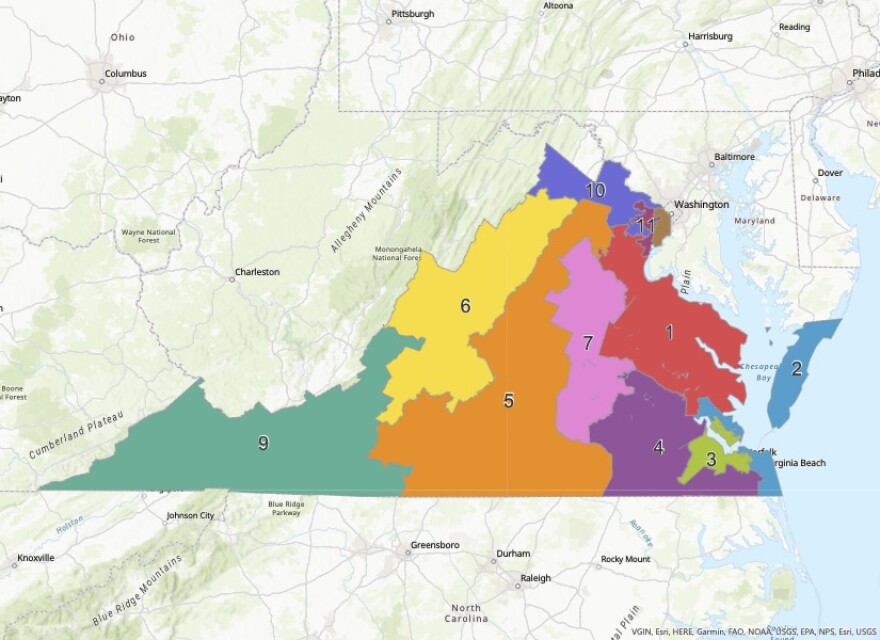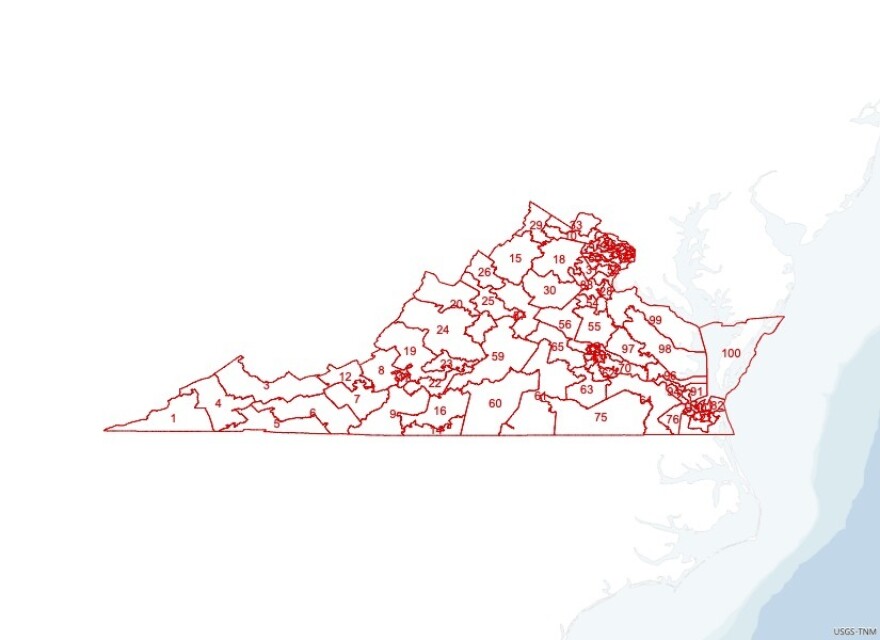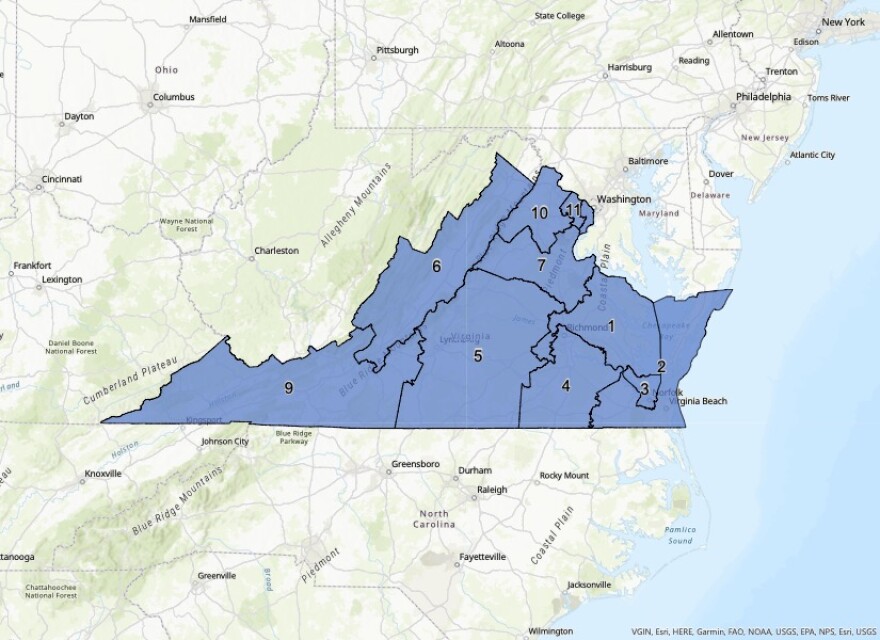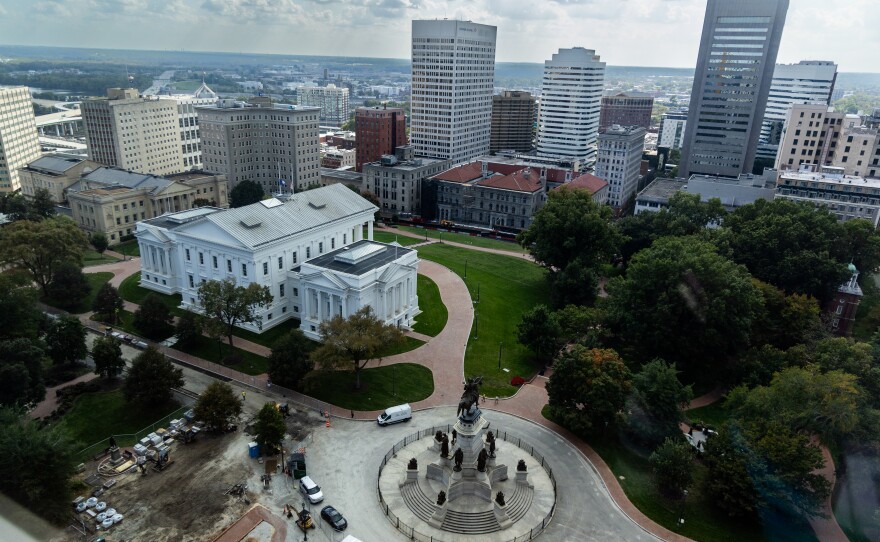Del. Lamont Bagby ran against Steve Imholt and won the race for Senate District 9 during the winter. Now, the Democrat is running as an incumbent in Senate District 14. But why?
Well, it’s because of redistricting.
What is redistricting?
Redistricting is a process that pulls information from the U.S. Census Bureau: In simple terms, it’s how new political boundaries are drawn. This means the redistricting process doesn’t just affect congressional borders, it can impact local elections and referendums — and even where people go to vote.
VPM News recently spoke with J. Miles Coleman, associate editor for the Center for Politics’ Sabato’s Crystal Ball newsletter. He’s also a political cartographer and understands the ins and outs of political maps, ranging from national to local.
“We typically think of redistricting in terms of congressional redistricting, which is definitely where it’s most visible, but that also applies to all kinds of other stuff [like] the Legislature,” Coleman said.
Redistricting usually takes place every 10 years, when the U.S. Census Bureau conducts a new population count; the most recent one was done in 2020.
Virginia also created a new system for redistricting in 2020. But now it’s 2023, and the commonwealth’s election maps are in place as of this year.

Why did redistricting change?
In 2020, 65% of voting Virginians passed a constitutional amendment on the ballot to establish a bipartisan commission that would redraw Virginia’s election maps.
Until that ballot measure, the General Assembly and the governor were responsible for drawing voting districts for the state Senate and House of Delegates, as well as the U.S. House of Representatives. The districts were required to be “compact and contiguous, and to have populations that are equal to each other.”
The amendment replaced that mapmaking process — and it added a failsafe: If the commission couldn’t finalize new, equitable districts, the state Supreme Court would step in.
The 16-person commission, which has both state lawmakers and Virginia citizens, was supposed to have new maps done by 2021, but that got pushed back due to the COVID-19 pandemic. The old maps were kept in place for the 2022 election, while the new maps were put in play for the 2023 elections.
Back to our example. Earlier this year, Del. Lamont Bagby won a special election over Stephen Imholt to fill now-Rep. Jennifer McClellan's seat in the 9th Senate District. And under the newly redrawn maps, the 9th SD is now the 14th SD in Virginia.
The former 9th SD was comprised of Richmond City and all of Charles City County. It also included parts of Hanover and Henrico counties.
The newly redrawn 14th SD is essentially the same area, but it has a new number.
Why did it take Virginia so long to redistrict?
Things got a little more complicated. The 2020 ballot measure stated that the new committee should be made up of legislators and citizens, but nobody could agree on criteria to draw up those maps.
And because they couldn’t agree, the commission didn’t release a finalized set.
That’s how it ended up before the state Supreme Court, which appointed two special masters (that's legal jargon for a court-appointed jobber) to overhaul the maps: RealClearPolitics writer Sean Trende to represent Republicans, and political scientist Bernard Grofman — who previously worked on several of Virginia’s political maps — to represent Democrats.
“The idea of taking redistricting out of the hands of politicians is fairly new,” Coleman said.
He said boundaries drawn by the special masters were much cleaner than what politicians had previously suggested.
“As someone who’s always looking at these maps, who has to analyze elections and maps myself, I like them in the sense that the lines [were] so much clearer,” Coleman said.

What was wrong with the old maps?
Gerrymandering.
In its simplest form, gerrymandering is where boundaries are manipulated to favor a political party or group of people. And over the past decade, redistricting reform has become a more prominent issue.
Following the 2010 Census, Republicans controlled the House of Delegates while Democrats controlled the Senate. That meant maps for both chambers were devised by opposing political parties.
Judges from the U.S. District Court for the Eastern District of Virginia ruled in June 2018 that 11 of Virginia’s House districts had been racially gerrymandered, concentrating Black voters. Republicans tried to appeal, but lost.
In 2019, the U.S. Supreme Court tossed out a case involving gerrymandering and Virginia’s redrawn legislative districts. The court ruled that the state’s Republican-led House of Delegates did not have any legal standing to pursue an appeal.
“They passed each other’s gerrymander,” Coleman said, noting that it was almost like a trade — where parties protected their own members.
He also referred to Virginia’s old maps as ones with “all these crazy looking lines” and a lot of split precincts. “It was really visually not appealing,” Coleman said.
Some localities were split multiple times: Coleman used Albemarle County — which was split three or four ways under the old maps — as an example. One of the carve-outs kind of looks like Godzilla.
What makes this year different?
Political cartographers started the old numbering system in Southwest Virginia, Coleman said, working upward and eastward through the commonwealth. The region’s population also has declined over time, which meant the numbers had to be reassigned.
“In Southwest Virginia,” he said, “you would see districts one, two, three and five. Then District Four, they had to eliminate a seat in Southwest Virginia — so they put it up in Northern Virginia.”

This is where it gets confusing. Because districts were renumbered in the new map, things have changed — leading to the questions of “I voted in X district in the last election, so why am I suddenly in a different one?”
The way the districts are numbered now is something new for voters: Essentially the same basic locations are covered, but with different numbers.
Now, districts are more compact and take population changes from the past decade into account.
Coleman used the 7th Congressional District as an example, one of the fastest-growing regions in the state. The old boundaries of the 7th Congressional District leaned more toward Central Virginia, including the entire counties of Amelia, Culpeper, Goochland, Louisa, Nottoway, Orange and Powhatan. Parts of Chesterfield, Henrico and Spotsylvania counties were also part of the old boundaries.
In the newly redrawn Virginia 7th CD, the boundaries have shifted to include all of Caroline, Culpeper, Greene, King George, Madison, Orange and Spotsylvania counties. The city of Fredericksburg, part of Prince William County and a very small sliver of Albemarle County are also included in the new district.
Essentially, the Interstate 95 corridor that runs from Stafford through Spotsylvania has become the new center of the redrawn district; a change from the former map, which had the district leaning more toward the south.
And it all goes back to the census. At the same time, voters will have to do their research to ensure they’re going to the right polling location.

Is that why X or Y lawmaker is on my ballot against my other X or Y lawmaker?
Yes.
In the upcoming election, longtime incumbents have found themselves challenged, and the makeup of Virginia’s House and Senate will be much different than before in part because of the turnover. Newer politicians will be replacing older ones who have had the wealth of generational knowledge.
Because of that turnover, veteran lawmakers who’ve been holding seats for what seems like forever aren’t returning.
There’s a much bigger political impact over the new maps. In the most recent General Assembly session, as Coleman puts it, “a flood of retirements” was announced.
Instead, fresh faces who may not know their way around Richmond as well as their predecessors will take seats in the General Assembly come January.
“Take it back to the Charlottesville-Albemarle area. Sen. Creigh Deeds is going to be our only veteran member this time, because we have two [open] seats in the House,” Coleman said.
Coleman thinks that once voters get used to the new maps, there won’t be as much confusion, because the lines are “much cleaner and easier to understand than what we had in place earlier.”
View Virginia's interactive election districts and voting precincts map.
Contact information for local registrar’s offices is available on the ELECT website. Voters can also confirm their polling place using the department's registration check tool.



